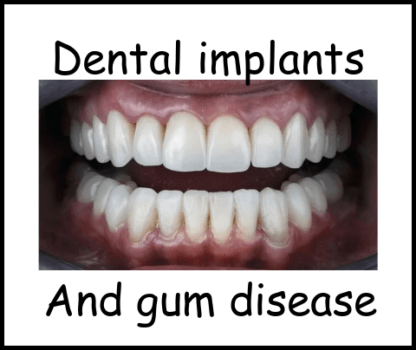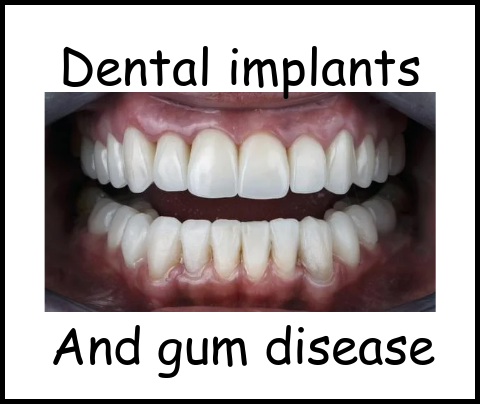Dental implants and receding gums
People with gum disease will ask about dental implants and receding gums, are they compatible, ?
Will receding gums prevent dental implant surgery, will unhealthy gums have a negative effect on the success of dental implants.
Gum disease is a more common in Ireland than you would think, according to the HSE.
Most of the adults in Ireland have a degree of gum disease.
In fact most of the population experience gum loss on at least one occasion.
Early signs of receding gums are gums will bleed when you are brushing your teeth, you may experience bad breath.
The early stages of gum disease are known as gingivitis.
If the early stages (gingivitis) are left untreated the condition will worsen, this is called perionditis.

Perionditis
Perionditis is a much more serious issue compared to gingivitis because it affects the tissue surrounding and supporting your teeth.
The gum tissue also holds the teeth in place, but it can become infected.
Without treatment periondtitis will cause damage to the jawbone causing small spaces to open up between your gums and teeth.
These small spaces cause teeth to loosen and eventually they will fall out.
Dental implants are recommended when teeth fall out.
So, with these unhealthy are dental implants and gum disease going to work.?
Healthy gums for dental implants
Dental implants can do a remarkable job in replacing teeth, they are so good at looking and acting like real teeth.
However, they do need healthy gums.
It’s not possible to get dental implants with gum disease until a periodontist has treated your gum disease.
Once gums are healthy again the treatment is possible, even if you have awful teeth treatment is possible.
What does a dental implant do
A dental implant does a good job of replacing the root of the tooth, when it is implanted it fuses with the surrounding bone.
It’s made from titanium and is placed where the tooth root was.
It provides stability and support for the abutment, crown or dental bridge.
This is the first part of dental implants and gum disease treatment.
The patient returns home for a period of 4-6 months to allow osseointegration to take place( bone fusion).
The first part of the treatment is crucial to the success of dental implants after gum disease.
The implant must fuse with the bone or it will fall out.
Why would implants not work
There are a couple of different reasons why implants would not work:
- The underlying bone may not be thick enough or wide enough to support the implants. Gum disease may be too far advanced and the jawbone has deteriorated too much.
- Gum disease will over time eat away at gums, dental implants need sufficient gum tissue for support.
Does gum disease mean that you can’t have implants
Gum disease and dental implants can go hand in hand if the patient is willing to undergo certain procedures and treatments.
For patients in the mild to moderate gum disease stage the disease has to be brought under control.
To achieve this the patient will need to visit a dental clinic on a regular basis where frequent teeth and deep gum cleaning will be necessary.
Basically the periodontist will clean out the gum disease through a process of deep cleaning.
The patient will be made aware that smoking, drinking alcohol, sugary foods and drinks are off limits whilst this treatment is ongoing.

Receding gums have cleared up
The gum disease has cleared up, the patient should then contact a dental implant specialist like Hungarian Dentists in Wexford.
Call Fintan Duggan on 0873490104 for more advice on dental implants and receding gums.
Make an appointment in Wexford where low cost dental implants are available.
Our Hungarian dentists will perform an extensive investigation of your mouth, teeth and gums.
This investigation is important to find out how far advanced gum disease is.
Surgery may be necessary before implants can be used.
Bone grafting for dental implants after gum disease
Bone grafting for dental implants involves using the patient’s bone or other bone to build the bone structure back up.
The gums may need grafting via healthy tissue extraccted from the roof of the mouth.
As soon as the dental implants are in place temporary crowns are made from porcelain to allow the patient to eat and chew food.
Then they are free to go back home until the final step.
Final step after gums have healed
The final step follows after the gums have healed and the implants have successfully fused with the jawbone.
The final step is the permanent placement of the brand new set of teeth that will look exactly like normal teeth, behave like normal teeth.
They also look fantastic and will bring a smile to your face.!

Conclusion on dental implants and receding gums
I hope that you have enjoyed reading this post entitled dental implants and gum disease.
The article was researched and written by me, Fintan Duggan.
I’m the local Irish coordinator for Hungarian Dentists Wexford and our state-of-the-art sister dental clinic in Hungary.
The clinic is called Perfect Smile Dental Implant Centre.
My phone number is 0873490104, you are free to call me anytime for advice on dental treatments in Hungary.
Gum disease and dental implants can work together providing the gum disease is treated and enough bone and gum tissue exists to take the implants.
References
https://www2.hse.ie/conditions/gum-disease/#:~:text=Most adults in Ireland have

